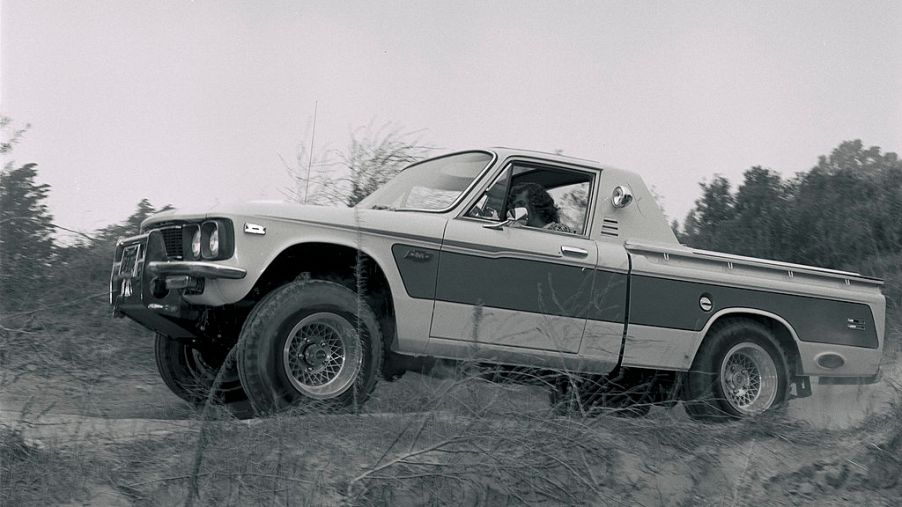
The Chevy Luv Was a Loveable Little Truck That Was Actually Made by Izusu
A big pickup truck has imposing looks, a huge payload, and massive towing capacity. It takes on all the hard jobs and polishes them off without difficulty.
But let’s take a moment or two to praise the mini-truck, which gained popularity in the ’70s. Like its bigger counterpart, it got the job done but also somehow looked cute at the same time.
One of the most beloved mini-trucks was the Chevy Luv. People tend to believe that this truck was an original design by Chevrolet, but the Luv was actually made by Isuzu. Here’s the story of this endearing little truck with some background information from TheFastLaneTruck.com.
A brief history of the Chevy Luv
Japanese-made compact trucks became available to U.S. buyers in the late ’50s, but their popularity only began to grow in the early ’70s – especially on the West Coast.
The Chevrolet LUV (Light Utility Vehicle) – also known as the Chevy Luv – was one of these trucks. This fuel-sipper debuted in 1972, a year before the 1973 oil crisis. Chevrolet claimed that gas mileage for the Luv was 24 mpg city and 34 mpg highway, according to Hemmings.com.
This little truck was actually a rebadged Isuzu Faster pickup. But from its introduction until 1982, nearly a half a million buyers didn’t mind that their truck wasn’t a real Chevy.
The Chevy Luv was configured just like other trucks at the time but in miniature. It had a 102.4-inch wheelbase and was built on a ladder frame. A big surprise about the Luv was that it had a 6-foot bed, despite its mini size. The net payload for the truck was 1,125 pounds. It also had unequal-length A-arms suspension in the front and a solid rear axle on leaf springs in the back.
Just one engine choice was available: a 1.8-liter SOHC inline four-cylinder engine that made 75 hp and 88 lb-ft of torque. It was paired with a four-speed manual transmission that only controlled the rear axle. A recirculating ball steering system and front and rear drum brakes were other features on the truck.
The Chevy Luv’s evolution
In the early years following the Chevy Luv’s introduction, Chevy made a few minor increases in power and capacity. Buyers also liked the addition of the Mikado trim upgrades. But the most significant advancements were Chevy’s offering a three-speed automatic transmission in 1976, larger bed options in 1978, and four-wheel drive in 1979.
The last option was a huge leap forward because it made the Luv one of only a few small 4X4 trucks with independent suspension. As a result, the Luv was at the top of its class in off-road performance characteristics, and sales for the little truck that year peaked at over 100,000.
Despite these upgrades, the Chevy Luv was still sluggish. It offered no crew cab option and lagged behind Datsun and Nissan mini-trucks in popularity. Rivals such as Dodge/Mitsubishi, Ford/Mazda, and even Chevy’s partner Isuzu were on the verge of making moves that would threaten the Luv’s following.
In 1980 Chevy released the second generation of the Luv. This version sported a matte, aerodynamic sheet metal skin. But with the slightly boosted 80-hp 1.8-liter inline-four or the available 2.2-liter engine that made only 58 hp, the Luv still literally lagged behind the competition.
Buyer response to the little truck dwindled in the very early ’80s. Finally, in 1982, the Chevy S10 took the place of the Luv.
The company that actually made the truck
Meanwhile, Isuzu was building its own pickup truck fan base in the U.S., including the P’up. The P’up was actually another version of the Isuzu Faster with the same engine options as the Luv. The Japanese automaker was selling the P’up in the States at the same time Chevy was selling the Luv.
Isuzu continued to make the truck but started using the Chevy S10 platform and rebadged it as the Hombre in 1996. In 2002, the Hombre was discontinued in the U.S.
Today, small truck fans appreciate the attractiveness of the first-generation Chevy Luv. Some of them discovered that the puny 1.8-liter engine could be swapped out relatively easily for a Chevy small-block 5.7-liter V8. This exchange transformed the unassuming Luv into an amazing drag racer.
Will there ever be a comeback for compact trucks? It’s hard to tell. But since compact SUVs have recently gained popularity, it’s entirely possible that the market still has room for mini-trucks—we can hope so, at least.


